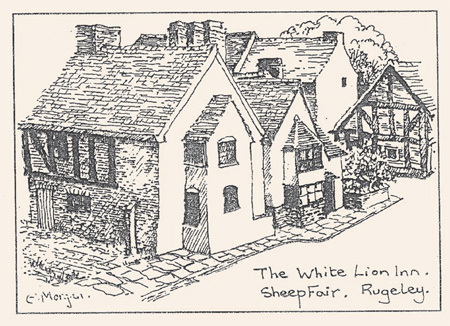Signposts from the past
This now quiet street was once packed with sheep
brought in from the surrounding heathland to be sold
on market day. The noise of bleating and shouting,
and the smell of dung and sweat have gone now, but
the wide street remains.

This sheep fair of around 1900 at Builth Wells, Powys, gives us an
impression of how a sheep fair was organized in a small town.
Courtesy Powys County Archives Office
The name Sheep Fair tells us what happened here – even though sheep have not been sold here for many
decades. Nearby street names also give us clues to
the past. Lion Street is named after the White Lion, a
public house now demolished.
The area was designated a Conservation Area in 2004

The White Lion coaching inn stood on the corner of Lion Street.
Drawing courtesy of Edwina Morgan
It’s all Greek to me
Crossley Stone House was built in the
18th century – a time when people greatly
admired the ancient civilizations of Greece
and Rome. You can find evidence of this
reflected in details such as decorated pillars
and rigid symmetry.

Pinfolds were simple enclosures, like this
one at Wellow, Nottinghamshire

Not all tithe barns were as grand as this one
at Middle Littleton, near Evesham
Copyright of Elke at www.picturesofengland.com
|
Hagley Hall
Elmore Park was once part of the
Hagley Hall estate. In the 14th
century, land in Rugeley passed to
the de Thomenhorn family, who were
granted the office of the Keeper of
the Royal Forest of Cannock.

The office became associated with the
sub-manor of Hagley. In about 1392
Thomas de Thomenhorn built the
original Hagley Hall, which included a
chapel, a kitchen, two barns, a
brewery, a stable, an ox stall, and a
gatehouse and drawbridge. The hall
probably stood on the island in the
middle of Elmore Park.
In 1636 a new Hagley Hall was built by
Sir Richard Weston. The hall changed
hands several times, and in the 18th
century it was extended and
remodelled.
In about 1930 the hall was partly
demolished. When the Western Springs
by-pass was built in 1956, it isolated a
small section of the estate. This was
later turned into Elmore Park.
What remained of the house fell into disrepair and was pulled down in the 1980s.

An east view of the grounds of Hagley Hall, showing
the house in the distance. This pen and wash drawing,
by J Allport, is dated 4th May 1814.
Courtesy of the Trustees of the William Salt Library, Stafford

|
There are lots of clues to the past
around Sheep Fair. Here you can
find reminders of a time when
the streets were muddy, and you
can look out for the differences
between buildings on a street.

Bow Street builders
These terraced houses fall into two styles, which often suggests that stretches of land were bought by different builders. The housing details tell us where one builder might have taken over from another, each offering distinctive attractions
to the buyer.
You can find changes of builder in terraces all over Rugeley. |
Have you trodden in something?
Look down to see boot-scrapers next to doorways around Sheep Fair. The streets used to be very
muddy in wet weather, and
since horses were the main
form of transport, you had to
be careful where you trod!


Giving your public house a face-lift
Like many buildings in Rugeley, part of The Vine
public house is timber-framed, but was covered
with a cladding of expensive facing-bricks when
this became fashionable. You might recall seeing
other timber-framed buildings in Rugeley. Their
owners may have been people unable to afford
the cost of appearing up-to-date.
|











